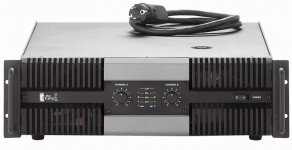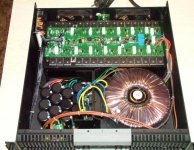The first 5 opamps and the circuitry around them might give you a clue to the lost bass.
But PA/PRO amps are deliberately designed to remove the damaging low bass signal from the speaker terminals.
But PA/PRO amps are deliberately designed to remove the damaging low bass signal from the speaker terminals.
Andrew T:
I too don't want low bass but i want more kick bass.
U hv mentioned about lost bass. Can u suggest how to change this?
The first 5 opamps and the circuitry around them might give you a clue to the lost bass. But PA/PRO amps are deliberately designed to remove the damaging low bass signal from the speaker terminals.
I too don't want low bass but i want more kick bass.
U hv mentioned about lost bass. Can u suggest how to change this?
I know this.Buy a parametric equaliser and add boost around 80Hz.
But here the suggestion reqd is for getting more kick bass from the amp itself.
Add the EQ directly to the amp? Series RLC to GND directly from the - input of the 2nd op amp. 470 ohms, 3uF, and 1.3H. It's for 80 Hz, Q of about 1.4 (same as turning up that band of an ocatve EQ). The 1.3H can be synthesized with an op-amp circuit - I don't rememeber the exact circuit off the top of my head - but it's in most comprehensive op-amp data books and app notes.
Now why do you want to boost *80*? EEEEEEyuck!
Now why do you want to boost *80*? EEEEEEyuck!

Add the EQ directly to the amp? Series RLC to GND directly from the - input of the 2nd op amp. 470 ohms, 3uF, and 1.3H. It's for 80 Hz, Q of about 1.4 (same as turning up that band of an ocatve EQ). The 1.3H can be synthesized with an op-amp circuit - I don't rememeber the exact circuit off the top of my head - but it's in most comprehensive op-amp data books and app notes. Now why do you want to boost *80*? EEEEEEyuck!
The bass is loose. I wanted tight bass. Many say that higher damping factor gives tight bass.
in the following thread :
http://www.diyaudio.com/forums/showthread.php?postid=1255792#post1255792
djk said :
Try adding a pair of 47µF at 63V (or higher) in parallel with the main filter caps. The bass will sound much tighter.
Here i want to say kick bass or more tighter bass. Sorry if misunderstood. Can the damping factor be improved?
"Tight" bass is the absence of all that excess 80 Hz goop. It's usually a function of the speakers. I would venture to say that any loose bass is not necessarily the amp's fault here. It has more than enough output transistors, 3 current gain stages, cascode VAS, and more filtering than they put in the QSCs and Crowns. At low frequency, the feedback factor is probably already to the point of diminishing returns. The only way the amp would be at fault is if they really did something wrong in the build or layout. That has more to do with it than you might think, and none of that is obvious from a schematic.
Personally, I would have used a darlington (C5200+predriver) in the driver stage of the high side banks. I did this with my S-Leach/class G experiment. I liked the SQ of the original class AB version better for driving top cabs, but for bass there isn't much difference going class G (other than how hot the amp and extension cord feeding it get). The MJE15033/032 pair will get pretty toasty like it is, and it won't handle 2 ohm loads as well as it should. But that will only affect behavior near clipping, and wouldn't be any worse than what the QSCs do.
I got suggestion to hv 40~50 hz cutoff. If ok, then how to do this in the schematics or add another HP filter board? ?
By Andrew t:The first 5 opamps and the circuitry around them might give you a clue to the lost bass.
I agree .. try bypassing all the opamps ,drive the amp directly
("PA" direct to first stage) WOW ,is this amp huge or what!!😱
What are the rails at 120-0-120V ???
Also ...C's with ?? marks at input + NFB loop ,what are they???
I agree .. try bypassing all the opamps ,drive the amp directly ("PA" direct to first stage) WOW ,is this amp huge or what!! What are the rails at 120-0-120V ??? Also ...C's with ?? marks at input + NFB loop ,what are they???
This means no need to keep opamps in the path. Just bypass it.
The amplifier is huge.
I hvn't checked the supply rate.
I will check the value of C in the feedback path.
My money would be that the amp is not the problem - its the speakers. This is why speaker/amp combos for bass guitars have huge speakers usually designed for this sort of work.
I tried this also.My money would be that the amp is not the problem - its the speakers.
The same speakers under same conditions give more powerful bass with another amplifier.
i agree the amp is not the problem, its the speaker system. why not build a kick bin for that tight and punchy sound. Try this site www.speakerplans.com. Hope this helps.
best regards,
audiomachines
best regards,
audiomachines
ostripper :
This means that the gain is just 20.
I think it will be better to increase the gain to 33.
So i will replace the 24k resistor feedback resistor with 39k.
Plus should i replace 100/25V bipolar with 220/25vBP or more.
I located the components. The c? is 100/25v BP. But the resistor in series with it is 1.2k.Also ...C's with ?? marks at input + NFB loop ,what are they???
This means that the gain is just 20.
I think it will be better to increase the gain to 33.
So i will replace the 24k resistor feedback resistor with 39k.
Plus should i replace 100/25V bipolar with 220/25vBP or more.
If you are not needing to have the input level control at max then you don't need more gain. Changing gain will affect the stability of the amp.
sreten:
So what i am going to do is right. Increasing the gain in limit which is not extended upto oscillation.Increasing amplifier gain improves stability, reducing gain is the no-no.
t-amp proline 3000
hi, is this your amp?
The amplifier is with heavy duty transformer & power supply. It is used for pa. But there is no powerful bass as required. What modifications might be required to get kick bass for PA use.
hi, is this your amp?
Attachments
- Status
- Not open for further replies.
- Home
- Live Sound
- PA Systems
- Help reqd - power bass for PA use

